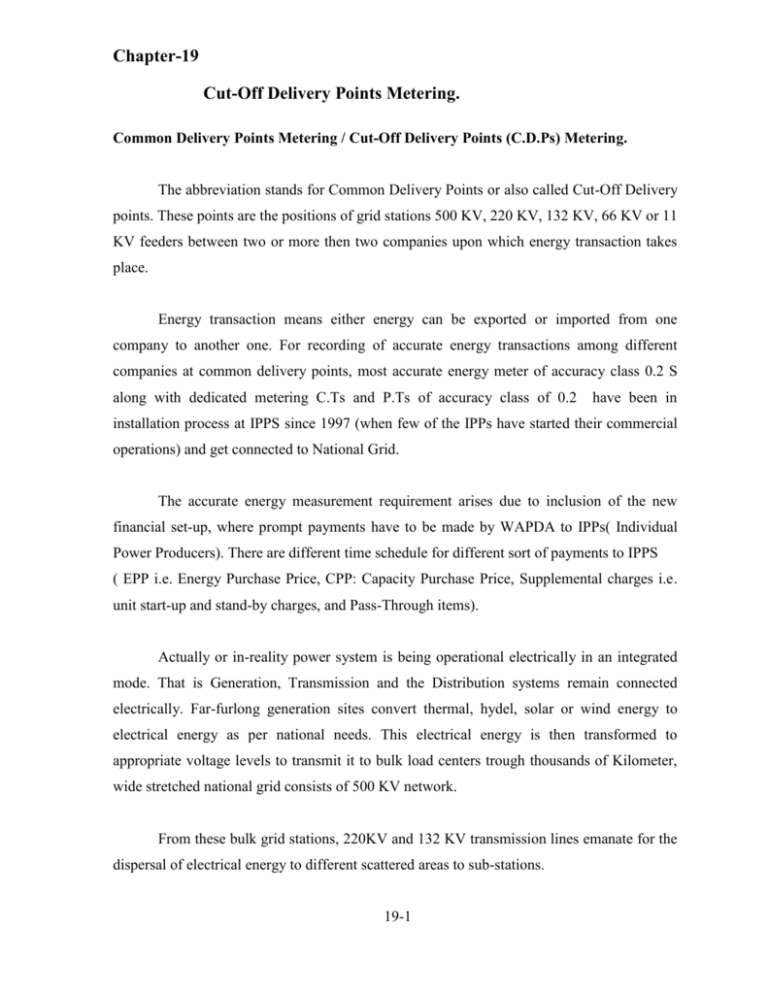Chapter-19 C.D.Ps
advertisement

Chapter-19 Cut-Off Delivery Points Metering. Common Delivery Points Metering / Cut-Off Delivery Points (C.D.Ps) Metering. The abbreviation stands for Common Delivery Points or also called Cut-Off Delivery points. These points are the positions of grid stations 500 KV, 220 KV, 132 KV, 66 KV or 11 KV feeders between two or more then two companies upon which energy transaction takes place. Energy transaction means either energy can be exported or imported from one company to another one. For recording of accurate energy transactions among different companies at common delivery points, most accurate energy meter of accuracy class 0.2 S along with dedicated metering C.Ts and P.Ts of accuracy class of 0.2 have been in installation process at IPPS since 1997 (when few of the IPPs have started their commercial operations) and get connected to National Grid. The accurate energy measurement requirement arises due to inclusion of the new financial set-up, where prompt payments have to be made by WAPDA to IPPs( Individual Power Producers). There are different time schedule for different sort of payments to IPPS ( EPP i.e. Energy Purchase Price, CPP: Capacity Purchase Price, Supplemental charges i.e. unit start-up and stand-by charges, and Pass-Through items). Actually or in-reality power system is being operational electrically in an integrated mode. That is Generation, Transmission and the Distribution systems remain connected electrically. Far-furlong generation sites convert thermal, hydel, solar or wind energy to electrical energy as per national needs. This electrical energy is then transformed to appropriate voltage levels to transmit it to bulk load centers trough thousands of Kilometer, wide stretched national grid consists of 500 KV network. From these bulk grid stations, 220KV and 132 KV transmission lines emanate for the dispersal of electrical energy to different scattered areas to sub-stations. 19-1 132 KV network than feed different area electricity boards (formerly), from where 11 KV feeders emanate to distribution areas, and finally step-down distribution transformers provide 400 volts three phase /230 volts single phase supply to the consumers. The WAPDA’s integrated previous set-up was as under: Generation: a. Hydel. b. Thermal. Transmission: Primary 500 KV Secondary 220 KV and 132 KV. Distribution: 08 Area Electricity Boards Country wide.* Primary 11 KV Secondary 400 V /220 V * Under previous set-up of WAPDA distribution system, following eight area electricity boards were functional. Area Electricity Board Peshawar. Area Electricity Board Islamabad. Area Electricity Board Lahore. Area Electricity Board Faisalabad. Area Electricity Board Multan. Area Electricity Board Hyderabad. Area Electricity Board Sukkur. Area Electricity Board Quetta. WAPDA remained profitable since its establishment in 1958 and catered for the national irrigational and electrical energy needs successfully. It rose from almost 600 MW to almost 12000 MW of its installed capacity, from its inception upto1990. 19-2 But on word, due to many reasons, it starts sustaining heavy financial loss. The drastic growth of energy demand (owing to technological improvements) can not be met with and the difference between demand and supply appears as an evil named as load shedding. As to cope with this evil, in urgency private sector was invoked to put-in the thermal generation in the system. So initially the points of connection of an IPP with national grid were established as C.D.Ps. After word, the costly generation from IPPs and increased distribution losses, WAPDA’S financial loss and circular debt started increasing. To sustain it from this condition, help was envoked from IMF (International Monetary Fund) and World Bank to get loans on easy terms. As a contingent requirements of IMF and World Bank, which suggested to break-up the heavy WAPDA system into small companies through privatization. Initially, work had been started by corporization to reach the ultimate goal of privatization. From year 2000, Generation, Transmission and Distribution sectors have been disintegrated administratively and financially. The WAPDA’s administrative/ financially dis-integrated new set-up (privatized) has been established as under: Generation: a. WAPDA Hydel (Large and Medium Dams). b. Thermal generation has been divided into four Generation companies called GENCOS. GENCO-I: TPS Jamshoro + TPS Kotri. GENCO-II. TPS Guddu + Sukkar + Quetta. GENCO-III.TPS Muzaffargarh + NGPS Multan + SPS Faisalabad + Shahdara Lahore. GENCO-IV. Lakhra 19-3 c. IPPS (Idependent Power Producers). d. RPPS ( Rental Power Plants) Still in dispute. National Transmission and Dispatch Company: Distribution: Primary Transmission: 500 KV. Secondary Transmission: 220 KV. 10 DESCOs (Distribution Electricity Supply Companies) have been established .* Primary Voltage Level: 132 KV. Secondary Voltage Level: 11 KV. Tertiary Voltage Level: 400 V /220 V. 10 DESCO are named as below: TESCO Tribal Area Electricity Supply Co. PESCO Peshawar Electricity Supply Co. IESCO Islamabd Electricity Supply Co. GEPCO Gujranwala Electricity Supply Co. FESCO Faisalabad Electricity Supply Co. LESCO Lahore Electricity Supply Co. MEPCO Multan Electricity Supply Co. SESCO Sukhur Electricity Supply Co. HESCO Hyderabad Electricity Supply Co. QESCO Quetta Electricity Supply Co. After privatization, the above mentioned companies remained operational. In order to segregate the financial payments for the energy transactions, the other Cut-Off Delivery Points have been established, as under. - IPPs to NTDC Network - IPPs to DESCO concerned. 19-4 - GENCOS to NTDC Network. - GENCOS to DESCO concerned. - WAPDA Hydel to NTDC Network. - WAPDA Hydel to DESCOS - NTDC Network to DESCOS. - DESCOS to DESCO. The Common Delivery Points established by CPPA ( Central Power Purchase Agency) as during the year-2009 have almost greater than 430 points. A detailed list of CDPs is being provided on the next pages. Common delivery points between IPPs and NTDC have already been equipped with most accurate energy meters of accuracy class of 0.2S with dedicated C.Ts and P.Ts of same accuracy class because the interconnection points have been built recently. The set-up as far as IPPs are concerned, is such that two types of energy meters of accuracy class 0.2S for each interconnection point are installed in a separate metering room, one as primary energy meter and second as back-up energy meter. The access to these primary energy meters has been restricted only to authorized personals being the property of NTDC. However access to back-up energy meters have been allowed to IPPs for their usage and is the property of IPPs. The duplicate metering set-up ensures availability of the energy transactions in case any one system gets faulty. The permissible difference between primary and back-up metering is 0.5 % as per PPA ( Power Purchase Agreement). But other CDPs have operational with the newer and better accuracy class energy meters of accuracy class 0.2S, but with already existing older and poor accuracy class C.Ts and P.Ts of class 1.0 or 0.5. Lack of provision of the dedicated C.Ts and P.Ts on these left over points do not solve the purpose of better overall accuracy class. Hence these remaining CDPs are being in up-gradation phase by installation of the dedicated C.Ts and P.Ts and will be briefly discussed under S.M.S Metering in the upcoming chapter (chapter-20), which stands for secure metering system. 19-5









